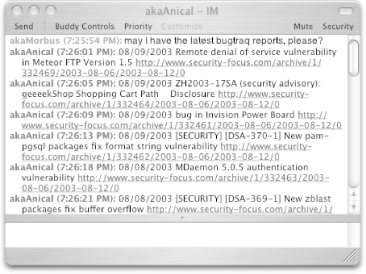Hack 99 Creating an IM Interface
| Add some Perl code here, an AOL Instant Messenger account there, and one of your favorite scraping scripts, and you have yourself an automated instant-messaging bot . AOL Instant Messenger (AIM) isn't the most likely place you'll need to scrape data, but that doesn't mean the applications aren't fun to connect. With Perl and the Net::AIM module (http://search.cpan.org/author/ARYEH/Net-AIM-1.22/), you can have your own bot perform multiple scraping tasks at your behest. First you'll need the Net::AIM library. It provides all the functions for logging into AIM and sending or receiving messages. To get a jump start on coding, check out Wired Bots (http://www.wiredbots.com/tutorial.html). They have some fully functional sample bots and lots of example code for working with Net::AIM . You'll also need an AIM screen name and password for your new assistant, along with a screen name for yourself if you don't already have one. The CodeTo show you how easy it is to add IM connectivity to your scripts, we'll modify one from [Hack #80]. Save this script as bugbot.pl : #!/usr/bin/perl -w use strict; use LWP::Simple; use HTML::TableExtract; use Net::AIM; my $aim_un = ' your AIM name '; my $aim_pw = ' your AIM password '; # the base URL of the site we are scraping and # the URL of the page where the bugtraq list is located. my $base_url = "http://www.security-focus.com"; my $url = "http://www.security-focus.com/archive/1"; # get our data. my $html_file = get($url) or die "$!\n"; # create an iso date. my ($day, $month, $year) = (localtime)[3..5]; $year += 1900; my $date = "$year-$month-$day"; # since the data we are interested in is contained in a table, # and the table has headers, then we can specify the headers and # use TableExtract to grab all the data below the headers in one # fell swoop. We want to keep the HTML code intact so that we # can use the links in our output formats. start the parse: my $table_extract = HTML::TableExtract->new( headers => [qw(Date Subject Author)], keep_html => 1 ); $table_extract->parse($html_file); # parse out the desired info and # stuff into a data structure. my @parsed_rows; my $ctr = 0; foreach my $table ($table_extract->table_states) { foreach my $cols ($table->rows) { @$cols[0] =~ m(\d+/\d+/\d+); my %parsed_cols = ( "date" => $1 ); # since the subject links are in the 2nd column, parse unwanted # HTML and grab the anchor tags. Also, the subject links are relative, # so we have to expand them. I could have used URI::URL, # HTML::Element, HTML::Parse, etc. to do most of this as well. @$cols[1] =~ s/ class="[\w\s]*"//; @$cols[1] =~ m(<a href="(.*)">(.*)</a>); $parsed_cols{"subject_html"} = "<a href=\"$base_url$2\">$3</a>"; $parsed_cols{"subject_url"} = "$base_url$2"; $parsed_cols{"subject"} = $3; # the author links are in the 3rd # col, so do the same thing. @$cols[2] =~ s/ class="[\w\s]*"//; @$cols[2] =~ m(<a href="mailto:(.*@.*)">(.*)</a>); $parsed_cols{"author_html"} = $1; $parsed_cols{"author_email"} = $2; $parsed_cols{"author"} = $3; # put all the information into an # array of hashes for easy access. $parsed_rows[$ctr++] = \%parsed_cols; } } # create an AIM connection . my $aim = Net::AIM->new; $aim->newconn(Screenname=>$aim_un,Password=>$aim_pw) or die "Cannot connect to AIM."; my $conn = $aim->getconn( ); # set up a handler for messages . $conn->set_handler('im_in', \&on_im); $conn->set_handler('error', \&on_error); print "Logged on to AIM!\n\n"; $aim->start; # incoming . sub on_im { my ($aim, $evt, $from, $to) = @_; my $args = $evt->args( ); ($from, my $friend, my $msg) = @$args; # cheaply remove HTML . $msg =~ s/<(.\n)+?>//g; # if the user sends us a "bugtraq " # message, then send back our data . if( $msg =~ /bugtraq/ ) { # send each item one at a time . foreach my $cols (@parsed_rows) { # format our scraped data . my $line = "$cols->{date} $cols->{subject} " . " $cols->{subject_url}"; # so as not to exceed the speed limit.. . sleep(2); $aim->send_im($from, $line); } } # give a warning if we don't know what they're saying . else { $aim->send_im($from, "I only understand 'bugtraq'!"); } } # oops! sub on_error { my ($self, $evt) = @_; my ($error, @stuff) = @{$evt->args( )}; # Translate error number into English . # then filter and print to STDERR . my $errstr = $evt->trans($error); $errstr =~ s/\$(\d+)/$stuff[$1]/ge; print "ERROR: $errstr\n"; } Notice that inside the on_im subroutine , it checks the incoming message for the word bugtraq before proceeding. It's a good idea to set up rules like this for any kind of queries you allow, because bots should always send a message about success or failure. This is also a good way to set up a robot with multiple capabilities; perhaps your next version will also accept bugtraq , similar to , or word lookup , all built using code from within this book. Running the HackStart up AOL Instant Messenger and add your new virtual screen name to your buddy list. When you run bugbot.pl , you should see the bot appear among your online buddies . Send a message that contains the word bugtraq , and you should get the latest security reports back, as shown in Figure 6-1. Figure 6-1. Bugtraq security reports through IM It's not exactly stimulating conversation, but expanding its vocabulary is simply a matter of adding further requests and responses to the script. Likewise, you're not limited by AIM; you can also use Net::ICQ , Net::Jabber , or similar modules. Paul Bausch and William Eastler |
EAN: 2147483647
Pages: 157